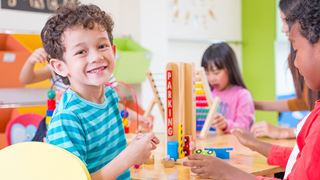Keeping Children Safe Online
There can be no doubt that more children are now accessing the internet than ever before. Apps, websites, streaming services and social media are available on all kinds of devices, and most children are being born into a world where learning how to use and navigate the internet is second nature.
The growing availability of internet-ready devices and the increasing popularity of social media apps have caused a dramatic increase in the number of young children accessing websites on a daily basis, and studies show that the majority now actually prefer playing online to more traditional pursuits, like watching TV. While some parents restrict their children's usage of mobiles, tablets and various devices, others are embracing it, despite the effects of the use of technology in the early stages of development being widely unknown.
Many early years practitioners argue that technology doesn’t have a place in the preschool education environment for several reasons, including the risk of dangerous content falling into the hands of the most vulnerable. Yet contrary to this, many studies have revealed huge benefits of incorporating technology into the learning processes of children, including improved retention of information, higher engagement and enhanced learning.
Technology isn’t something parents can run away from, with schools, libraries, shops and businesses utilising digital technology to keep up with competitors and make things easier for their customers and users. Preventing children from using technology will only leave them feeling left behind and curious as to what they are missing out on.
So if children and young people are going to use technology, how can we protect them from harm? In this article, we’re going to look at how this prevalence of online activity can lead to dangers, and how to keep children safe online.
Why is Internet Safety Important?
Unfortunately, the internet isn’t necessarily the safest playground. It's very easy for people to anonymise themselves online, and there is a perception that online actions have no real-world repercussions.
The more young children gravitate towards the internet, the more important proper online safety for children becomes. Bullying, from peers and adults, is an ever-present danger, and the sudden increase in the number of young children using open and public sites to chat has also attracted an elevated number of manipulative online predators - many of whom are very adept at disguising themselves and befriending unsuspecting children.
How Can Setting Online Safety Rules for Children Help?
It is possible to avoid most of these dangers by following some basic e-safety rules to keep children safe online. These should revolve around helping your child to avoid potentially dangerous situations, protecting sensitive data, and limiting your child’s access to sites and/or content that could have a negative impact on their health and well-being.
The most important thing to do when it comes to internet safety for kids is to explain the relative dangers of using the internet and share internet safety advice for children.
Explaining that they may be targeted by bullies, that people do act negatively, and that they do have to exercise caution if they don’t want to be targeted will go a long way towards preparing them for the dangers that they may face. Even something as small as taking the time to explain that it isn’t sensible to share private information, such as your full name and address with a relative stranger, can be enough to help them avoid a potentially dangerous situation once they are online.
Explaining that your child has the right to use the internet without feeling intimidated is also important. In an ideal scenario, your child would tell you whenever they were bullied, insulted or made to feel uncomfortable, and sitting them down to explain that this is the case will help to ensure that you can keep a handle on their experience.
How to Keep Children Safe on the Internet
By following the below internet safety tips for kids, you can help your child to be safe online and ensure that they use the internet responsibly whilst enjoying the multitude of highly beneficial content that’s available.
Parental Controls
Beyond helping your child to understand the dangers associated with the internet, you can also look into installing parental controls. These controls are normally offered by your internet service provider (ISP) and can be applied for the whole household; allowing you to choose what type of websites you allow your child to visit and then having the router block access to other devices.
Some devices also have built-in parental controls that offer a more flexible option if you want to be able to browse freely on your own computer but limit your child’s access to potentially harmful or damaging content.
On the majority of devices and computers, adults can set parental controls so that their child only has access to age-appropriate content. Most Internet Service Providers (ISPs) provide their customers with free controls that can be set at any time.
Alternatively, it's possible to buy or download parental control software, which is widely available in many different forms and prices online. Software like this will allow you to filter inappropriate content like pornography and violent material, so there is less chance of your children being exposed to it.
If you have more than one child but share a family computer or device, you will be able to set up various profiles based on your child's age and what you feel is appropriate for them to see.
Privacy Settings
Privacy settings can be used to limit the amount of data your child can accidentally share with predators or bullies and promote online safety for kids. Most devices have privacy settings that allow you to do things like banning apps from sharing location data.
Ensuring that you have selected the correct option can be the difference between your child remaining anonymous, and a bully being able to discover where they live. Many social networking sites such as Facebook have their own privacy settings too, so that you can keep your child’s account private until they are old enough to use the site independently.
Monitoring Options
Letting a child have control over their own internet use can be important in the development of their independence. But at the same time, it's irresponsible to let them go completely unsupervised if they’re still very young.
That's why it's advisable for adults to check out the various monitoring options available to them when their child is setting up a new account. Many online services offer parental control applications that allow guardians to keep track of usage or place limitations on certain features, such as voice communications or micro-transaction spending.
It may also be a good idea to set up a family email address for setting up online accounts for children, as this lets parents keep an eye on activity and notifications from youngsters' accounts without flooding their personal inboxes with spam.
Child-Friendly Apps
Touchscreen devices like tablets and iPads have proven to be some of the most popular devices among young children, mostly because they are easier to use and less likely to be damaged. However, if a child searches for a term that they might believe is completely innocent, explicit and harmful content may quickly appear on this device.
Parents can prevent this by downloading child-friendly apps that are catered to those aged under five and ensure child safety online. Simple apps like Shape Arts: Geometry Creations, Moose Math and LetterSchool make learning fun and interactive, replacing traditional childhood activities like painting and drawing. Instead of giving a child full access to the internet, start by letting them use these apps so that they become familiar with technology but aren’t at risk of coming across inappropriate content.
Child-Specific Devices
Over the years, tech companies have started to design tablets and devices especially for children. Devices like the iPad Mini have a number of parental features on their operating system, like restricting adult content from showing in the web browser or preventing users from downloading apps without approval.
There is also a range of different tablets that have been designed specifically for children’s use and only have apps and games that are child-friendly, with no option to access the internet or use messaging services.
Top Tips for Helping a Child Set up an Online Profile
One of the best ways of making sure that children are staying safe online is by helping them take precautions when setting up a new online profile. Profiles are needed to access a variety of sites and platforms, from gaming and social networking websites to essential resources used in schoolwork, and may pose a security risk if children aren't careful.
However, these risks are relatively easy to mitigate by following a few simple safety tips, allowing young people to get the most out of online services without putting themselves in any danger.
Pick a Safe Username
Choosing the right username is one of the most important parts of the process of setting up an online profile and ensuring safety for children on the internet, as children will need a name that allows them to find and interact with friends online without giving too much away about themselves.
As such, it's best to make sure that young people do not include their full names or birth years in their usernames, as this kind of personal data can easily be misused by malicious users. However, using a fake or misleading name should also be discouraged, as this is not conducive to the kind of honest, open interactions that young people should be having online.
Instead, it’s best to pick a nickname of some personal significance that is authentic without giving too much away.
Create a Secure Password
Password security is one of the most important methods for keeping users safe online, regardless of their age. If you’re teaching a child about staying safe online, you should make sure that they take this issue seriously early on.
Naturally, most kids' instinct will be to select a word they find significant or memorable, but they should be reminded that this could make it too easy for another user to guess, meaning their account and personal data could become vulnerable. An even worse idea would be to select something excessively generic, such as the word "password".
Creating a strong password can certainly incorporate some kind of memorable phrase, but it's best to mix it up by including a minimum of ten characters, including both uppercase and lowercase characters, and numbers as well as letters. Kids should also be encouraged to change their password regularly to provide an additional layer of protection.
Keep Personal Information Minimal
Many online profiles allow users to upload personal images. While many children find it fun to share pictures of themselves with their contacts, it's worth bearing in mind that these images can often give away more than was actually intended.
For example, it's best not to upload any photos with house numbers or street names visible in the background, as this could make it easy for troublemakers to track down a family's physical location; choices of clothing can also be a giveaway, especially if the photo features school uniforms. Parents and guardians should remember that many of the photos taken with modern smartphones are extremely detailed, so even a small piece of visual information that might look blurry or indistinct can be magnified by those with a reason for snooping.
FAQs
Why is internet safety important for children?
Internet safety is important for children because predators are increasingly using the internet as a method of targeting and harming young people. Without being aware of these risks and how to avoid them, children can easily fall victim and may not realise that what they are doing or sharing might put them in danger.
It’s also important to teach children about keeping safe online because there is a lot of content on the internet that isn’t suitable for kids and may be distressing or harmful if it is found accidentally. Along with putting appropriate measures in place to protect children from inappropriate content, you should teach them that this kind of content exists and encourage them to talk to you or another trusted adult if they see something that makes them upset.
What are the risks and consequences of a child using the internet?
One of the biggest risks of a child using the internet is that they’ll be groomed or targeted by a predator that wants to harm them. There is also the risk that a child will unwittingly share personal or private information that can be used to harm them.
Giving children access to the internet presents the risk that they’ll be exposed to inappropriate material, which can have a range of psychological and behavioural consequences. They also run the risk of sharing content online that may come back to harm them later on, such as old social media posts impacting their ability to get a job.
However, whilst all of these risks and consequences are possible, they are easy to avoid by teaching and sharing safety tips for children on the internet.
How do you explain internet safety to a child?
Promoting safe internet use among young people involves striking a difficult balance. On the one hand, it's important to make sure they're protected against the harassment and invasions of privacy they can face online, but on the other hand, it's unrealistic to think you can stop a child from using these services in this day and age.
The best way to explain internet safety for kids is to let them know about the risks and dangers of the internet so that they understand why they should follow advice for staying safe online. Make sure that they know how safety measures or procedures protect them and what they risk if they don’t follow children's internet safety advice, so that they have enough information to make informed decisions about their behaviour.
The information you share should be age-appropriate: there’s no point explaining the complexities of online safety to an 8-year-old that just wants to use gaming apps on their phone. Above all, encourage your children to talk to you about what they use the internet for and let them know that they can always share if they find content that they don’t like or understand.
Summary
It’s understandable for adults to be concerned about the dangers that the internet presents to children, especially young children that use devices and apps without really understanding the risks that they pose. The best way to protect young people is to equip them with the knowledge of how to stay safe online and the risks of unsafe internet use, and then monitor their behaviour to provide additional support or advice if needed.
If you’re a parent, teacher, or another individual who works with children and young people, you may find our online ‘eSafety’ course to be a valuable resource for learning how we can help to keep children safe online.









/safer-recruitment.jpg?mw=320&hash=A2BB5E144C89C295EC10C63680F69F39C4C3E566)




/e-safety-.jpg?mw=320&hash=A9FCF6B70F32AD3EA74633373FF0213B000F75FF)










































